|
|
|
Select comet to go to it's entry:
Well, FINALLY I got to view the Comet Hyakutake. After working overtime last night, I got home to a clear sky around 3:20 AM CST (9:20 UT). Took the 10x50 binoculars out and swept the southern sky. Took about a minute to locate the comet, but when I did, I was NOT disappointed. It was nicely framed near a bent row of 4 stars, the closest and brightest one to the comet was reddish in color. The center left of the comet seemed more condensed, and I got a distinct impression of a tail pointing west, slightly angled up toward northwest. The impression of the tail seemed to be about as long as the comet was wide in diameter (unable to give any specific size of the comet itself, although I would say that what I could see was about 1/4 degree to almost 1/2 degree). I also got the impression of a fan shaped coma toward the west as well. Neither the tail or fanning were well defined...just an impression.
I observed the comet again about 20 minutes later, and this time the condensation was more defined and centered, and I didn't get as strong an impression of the fan shape to the west. The tail impression remained however. The coma itself seemed more circular than in the previous view.
This was observed just outside the city limits of Chicago, so there's lots of light pollution here. The sky was clear, with a little haziness nearer the horizon. Naked eye, the sky seemed hazier around the comet than in the binoculars, so the comet wasn't detected without assistance.
I was quite impressed with the comet...the upcoming show should be quite good!
I just came in from a quick look at Hyakutake, from Chicago Illinois. It is naked eye, THROUGH CLOUDS (thick enough to obscure all except the brightest stars here), and with all the light pollution here! The comet only appeared as a round glow with the central condensation, but the coma was unmistakeable. Observed at 1:03A.M. CST (07:03 UTC) with the 10x50 binoculars and naked eye.
Observed and photographed (hopefully successfully) Comet Hyakutake again tonight. The weather was clear, with a bit of haze. Hyakutake was about 15 degrees north of Arcturus, nearly directly overhead, and easily visible to the naked eye. The central condensation was more point-like when viewed by naked eye, than it was in the 10x50 binoculars. In binoculars, the condensation in the nucleus appeared elongated in the direction of the tail. The view in the binoculars showed the fan tail again, pointing south/southwest, and there was a thin tail that extended at least one binocular field. The tail was thin in both width and density, but was more evident than the fan tail. The comet was more spherical in appearance this time (the fan tail wasn't as impressive as my observation on the 16th).
The comet's motion was VERY EVIDENT over the course of a half-hour. It was nicely framed below two stars, nearly even (below the star as viewed when I was facing east) with the closest star to the comet, at 12:27 A.M. CST (06:27 UT). At 01:00 A.M. (07:00 UT), the comet had moved north, making a triangle with the two stars. The movement is evident as shown in the following sketches:
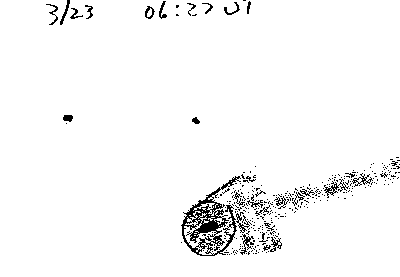
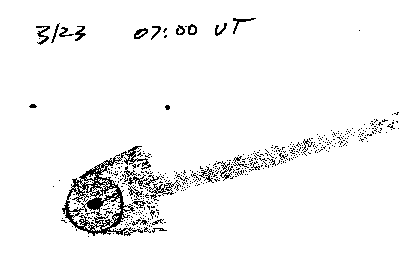
After clouds moved through the area, I was able to get a quick glimpse of the comet for a minute or two, at 12:25 A.M. CST (06:25 UT), then a longer look at 01:30 A.M. CST. The appearance is much different this time than from my observations over the last few days. The comet was high in the northern sky, the color was still the same pale blue that it's had every observation, and the nuclear condensation still had the creme color that it's had during those observations as well. The comet is really bright, very easily seen with the naked eye from Chicago. In this view, (in 10x50 binoculars) the comet actually had the appearance of a rock inside a cloud of material, rather than just a fuzzy sphere that was prevalent in my previous observations.
This time, the comet appeared to have a rayed look to it...the coma was homogenous, with the nucleus being a starlike point. The tail appeared to pass right overhead (from north to south, with the coma at the north end), and was spread out, as if looking at it from directly below. The entire tail took on the fan shape, beginning at the sides of the coma, spreading out wide overhead, and the comet no longer appeared to have the separate short fan tail with the longer streamlined tail. I got the impression of distinct "rays" in the tail. It didn't appear to have evenly distributed material. The view was fantastic, once again.
The sketch below shows the general impression I got.
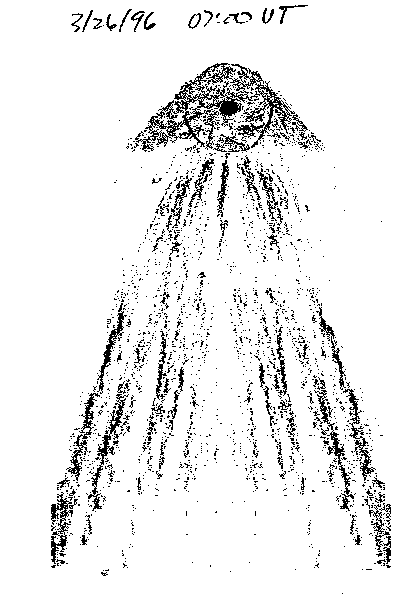
Took a quick look at the comet at 12:30 A.M. (06:30 UT). The comet pretty much looks the same as last night, except the coma is even less spherical now. There's a "bow shock" appearance at the head of the comet similar to the view from last night, but much more pronounced. The central condensation is well forward, near the forward edge of the coma. The tail eminates from the bow shock, so there's no spherical structure between the nucleus and the tail. So now, the comet's appearance is like a "fat arrow". The tail was thinner in width than it was last night as well.
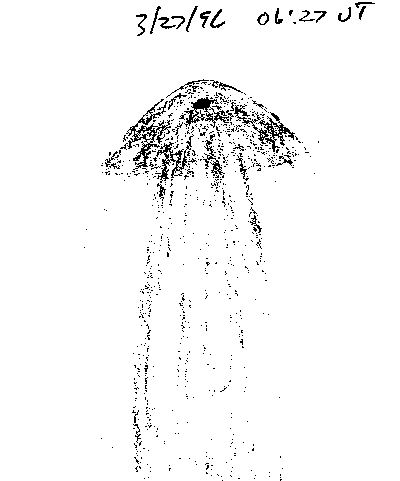
Update to my observations of Comet Hyakutake - after comparing my views with published photographs in ASTRONOMY magazine, I've determined that the thin tail that was visible in my early views was in fact the brightest tail filament that was very evident on the photographs, which show both it and the fainter, wider entire tail itself. The rest of the tail on both sides of the filament wasn't visible from my location due to the light pollution.
Also, my first attempt at photographing the comet on March 23rd
failed, due to the camera film transport malfunctioning. This resulted
in the film not being advanced for each frame, so all pictures occurred
on the same frame, including the reference pictures. These wiped out any
usable images from that roll. However, on my second attempt, which I
made on March 26/27th when the comet was near Polaris, I successfully
captured the comet. Not much detail is visible, other than the coma and
the tail being faintly visible, but the comet is not smeared due to it's
proximity to the pole (fortunately!). Unfortunately, the images suffer
from the light pollution, so there's insufficient contrast to scan and
post them. They were taken with an unguided tripod mounted (and OLD)
35mm manual camera, out of a north-facing apartment window.
On Feb. 13, 1997, I made my first observation of Comet Hale-Bopp.
This is quite a rare occurrence...first Comet Hyakutake was seen last
year, in March of 1996, and now another bright comet this year
(Hale-Bopp). Well, I FINALLY got to see Hale-Bopp this morning. Skies were
clear, and I managed to drag myself out of bed and go outside into the 13
degree weather, at 5:45 AM CST. (I'm a block from the Chicago city
limits).
The comet was an easy binocular object, even with twilight-brightening
sky, but it was invisible to the naked eye however. The "nucleus" was
elongated in the N/S direction (comet was almost due east, with the tail
pointing nearly straight up, with a P.A. of about 265 deg) being brighter
on the S. side, and that brighter part sweeping back along the part of the
tail that I could see (which was fan-shaped), following and slightly
inside from the southern edge of the tail. At first I thought the
elongation of the nucleus was a problem with my binocs, but then I
remembered about all the jet activity, and with the brighter part sweeping
back into the tail, that would confirm that it was indeed jet activity.
Comet/tail was parabolic in shape. The color was grey-white. From what I
could see of the comet (with twilight brightening and the ever-present
LP), it was about 30' in size, give or take a bit.
Overall, I'm impressed. I was expecting to not see much, based on the
photo's I've seen in ASTRONOMY and online. Was I surprised. Since
Hyakutake was my first bright comet, it still remains the most impressive
to me, but Hale-Bopp is coming in at a very close second. The show should
be nice!
Took another look at the comet with the 10x50 binoculars again this
morning, but twilight was too bright to show anything other than the
nuclear area of the comet. Due to the background brightness, no detail
was seen, and the view was in fact pretty poor, other than the fact that
the comet was indeed visible with a bright sky. It appeared that the
fountain on the southern side of the nucleus is still active.
Tonight, I saw the comet in the EVENING sky, about 10 degress up on the
NW horizon. My observation was at 6:45 PM CST (00:45 UTC). The comet was
easily visible by the naked eye (about mag 0), and binoculars showed it to
have two distinct tail sections. The tail was horizontal, with the
brighter part along the bottom (nearest the horizon). This is the same
section that contained the fountain I noted in my previous observations.
That part appeared slightly separated from the other tail section, making
it appear as a somewhat sideways V shape. The other tail section was
fainter, and curved up slightly. The nuclear area was not well defined,
but did appear stellar like at times (seeing wasn't very good). The
fountain in my previous observations was not well defined on this viewing.
I observed the comet at 7:10 PM CST (01:10 UT), while it was about 15
degrees up in the NW sky (10 degrees away from a streetlight). I could
easily see a naked eye tail, about 3/4 degree long. In binoculars, the
tail was easily 1.5 degrees, and there were two bright main areas
forming a V...one swept back into the tail, and the other area (shorter)
was pointing to the horizon. Mag was easily brighter than 0. The comet
now has the "usual" cometary appearance...coma followed by a sweeping
tail that expands slightly.
On March 27th, 1997, a coworker, friend and I drove to Nebraska from
Chicago to view and photograph the Comet Hale-Bopp. The skies were
absolutely fantastic, and the comet was gorgeous. We could see at least
10 degrees of dust tail, and 15 degrees of the ion tail.
To give an idea of how nice the skies actually were, on both nights
that we observed (Mar. 28 and Mar. 29), we could CLEARLY see the "zodiacal
light", which is light that's reflected off of dust in the solar system.
It was in the western sky for several hours, a bright spike that rose up
to about 1/3 the way to the zenith, and was pointing south at an angle of
about 60 degrees. It was so bright that it looked similar to skyglow from
a small town.
Starting at sunset, the comet was visually sighted about 20 minutes
after the Sun had set, and even with bright twilight, 2 degrees of the
dust tail could be seen. As the sky progressively darkened, the comet
grew quite nicely.
The first noticeable aspect of the comet was the curve of the dust
tail. The comet was in the N/NW sky, with the tail having an angle of
about 30 degrees up from horizontal, and it curved toward North.
In binoculars, and faintly noticed on short-exposure photographs, the
tail was brighter on the top half, almost divided straight down the length
of the tail. The 3-D appearance of the comet against the backdrop of
stars was startling as well.
In my 60mm refractor, the hoods around the nucleus were clearly seen,
toward the "front" of the coma, directly opposite of the tails.
We were out both on Friday night and Saturday night (March 28 & 29),
and it was a view I will not soon forget. Fortunately, I was able to get
at least one good shot of the comet (which made the trip entirely worth
it!), and have scanned that image and put it here.
Comet Hale-Bopp Observations, Feb.-Mar. 1997
Here is my observation and sketch of the comet:
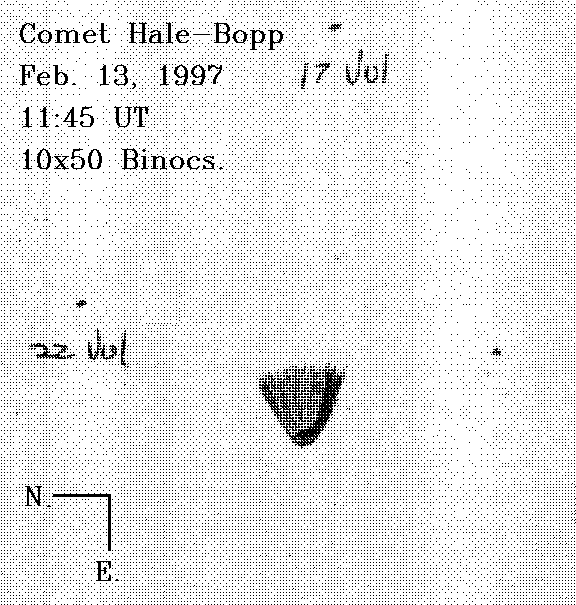
Next observation of Hale-Bopp, Feb. 25, 1997.

Comet Hale-Bopp Observation, Mar. 9, 1997
Hale-Bopp and it's tail easily seen from Chicago, Mar. 15, 1997
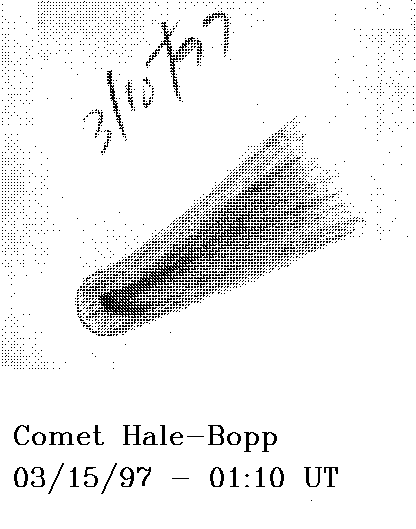
Hale-Bopp observing/photo trip to Nebraska, Mar. 27-30 1997
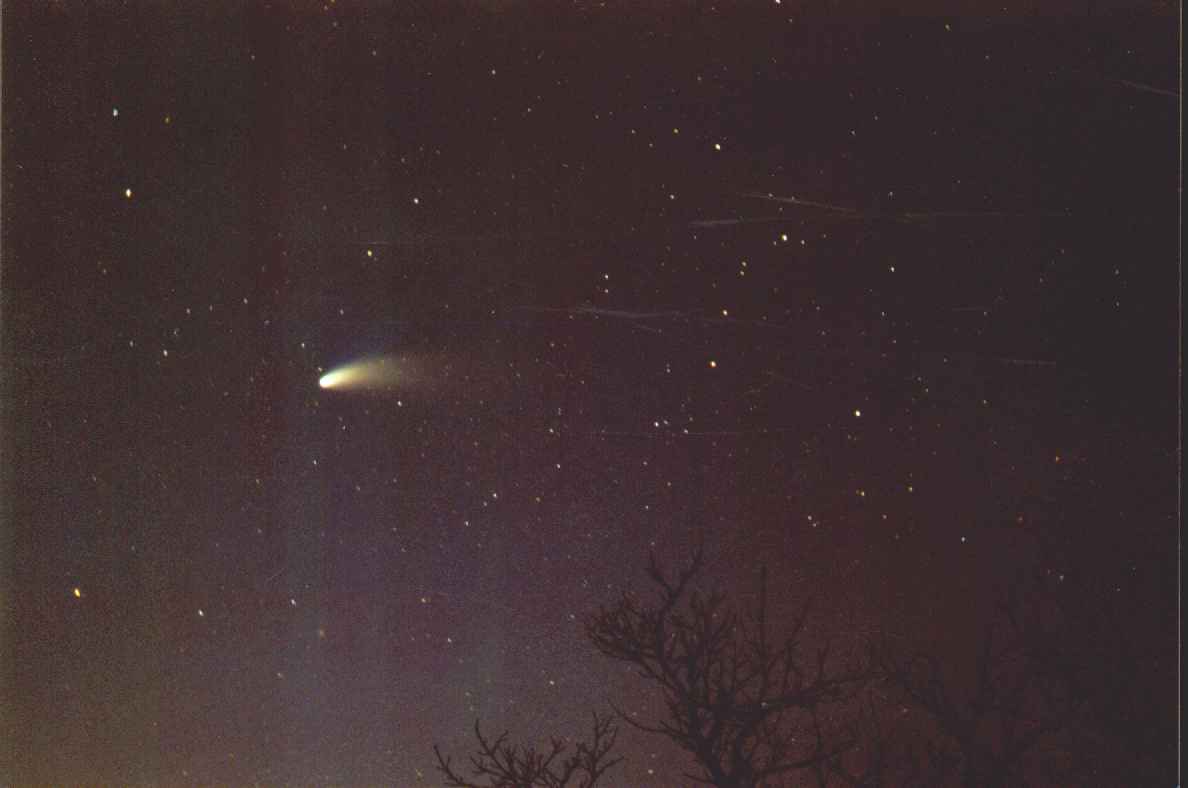

New Image of Comet 17P/Holmes - Oct. 27th, 2007. I took my 8" f/6 Newtonian out and was able to get some afocal shots through it with a rigged coupler that holds my digital camera to the eyepiece nicely. The image below is 3 stacked and processed images taken this way. It's grainy due to the camera auto-selecting the ISO value, but gives a view of what the comet looks like tonight. The fan structure from the nucleus is plainly evident. Visually, the coma looked smooth with little detail, other than the fan.

Return to main page.